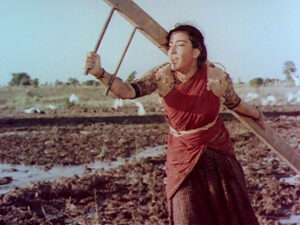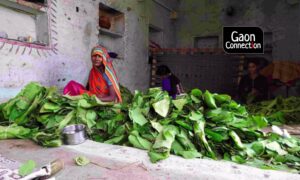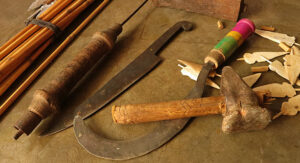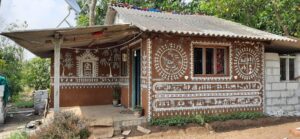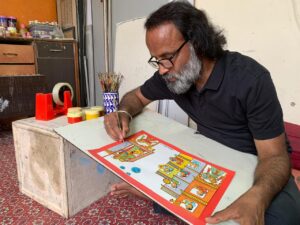Isn’t it beautiful to reminisce over yesteryears? How strange it is that we smile today remembering the things once we had cried buckets upon, and the things that had made us guffaw with friends in the past now tear us up. Bittersweet, isn’t it? Recently, a single tweet on Twitter opened up a similar spectacular cascade of memories. All the people recounted the words of the forgotten tongue and relived the time of their youth with the help of that tweet. Neelesh Misra, a successful lyricist of Hindi films and the famous storyteller, tweeted a picture of sarauta (the nutcracker) and wrote:
अपनी भाषा में ऐसे शब्द कहिए जो भूले हुए हों, बोलचाल में कम प्रयोग होते हों। हिंदी के अलावा किसी भाषा के हों तो अर्थ बताइएगा, और उस से जुड़ी कोई याद या बात। मेरी ओर से शब्द है — “सरौता”।मेरी नानी सरौता ख़ूब इस्तेमाल करती थीं।”जाओ पान वाले डिब्बे से सरौता ले आओ!” #SlowExperiences pic.twitter.com/8AWuDkK8yQ
— Neelesh Misra (@neeleshmisra) April 27, 2020
This tweet opened a floodgate of memories. Twitter users recalled the words forgotten in the fast-paced world and the small things that were once an integral part of our lives. Let’s share with you the reactions in which twitter users remembered various things and words and beautiful stories associated with them.
Sarauta (the nutcracker)
Do you remember paan (betel leaf) box? It used to occupy the place of pride upon a stool in a dedicated corner of the room and covered with a fancy piece of cloth. Belonging invariably to a grandmother or the house elder, it had numerous little brass katories brimming with kattha (catechu), chuna (lime), saunf (fennel), dali and it had a tiny sarauta. This small equipment for cutting dali often graced the hands of the elders. So, our childhood memories of their love, care, admonition, or even slight rebukes evoke the image of a sarauta. All the things that were told to us while trimming dali are today buried beneath thick dust of time, but are, nonetheless, alive. Referring to the tweet upon sarauta, a Twitter user named Sudha wrote: “We used to call it khilbatti, a small box-like container to keep paan. In the mornings, dadi jee used to make 20 paan and placing them in the khilbatti used to hand them over to the dada jee with her usual instruction: “Do make them last all day long for I won’t make anymore.” Dada jee, promptly, used to empty it out within two hours. Sarauta brought khilbatti to mind as supari (betel nut) used to be shaved with it.”
Several others agreed that the mention of sarauta sent them into the past. Another user wrote: “As kids, during the summer vacations spent in my grandma’s village, it used to be my job to bring my grandmother her paan things post-lunch. And I used to get Re 1 in bakhshish, which I faithfully deposited in my piggy bank. Today’s bank balance is insignificant in comparison to that joyful saving.”
Referring to sarauta, Shadab tweeted: “Sarauta disappeared from the memory with grandma’s passing away. Amma used it for kaseli (betel nut) and during Eid, the same sarauta was used to shave dried dates, coconut, and almonds for sewai. Now, the ready chopped nuts are found in the market, but it doesn’t have the same feel.”
Chakki (the mill)
The chalk used to be an ubiquitous fixture in every household courtyard. Recall the sound of two stones grinding against each other, the voice of the gharr-gharr, accompanied by eager conversations of women busy milling in the courtyard. Do you miss those sounds while emptying store-bought flour into large containers in your modern kitchens today? Many Twitter users pointed out that in their childhood, chakki was the most important member of their home. So much so that if someone’s foot touched it by accident, the person was required to put hands to it and take them to the forehead as a mark of respect. Of course, chakki is not found in the houses today and is relegated to a forgotten corner of the courtyard or dumped with other useless things.
Amol Kale of Maharashtra, while mentioned chakki, wrote: “In Marathi, it is called ‘Jatan’. Even today, in rural Maharashtra, almost all the houses will have a chakki, but it is not used as much.
Pervez Alam wrote while refreshing memories of chakki: “It was pretty much like a game for us as children to run chakki at the time. But we were forbidden to operate it. However, when Amma fell asleep in the afternoon, we used to have our fun rotating it sans any grains.
Mihir wrote: In Gujarat, chakki is called sudi. Upon seeing its image, all the memories associated with Nana Ji came alive.
While the user named Shiva said he had also run a chakki which is called janta in Magahi and daretiya in Awadhi. But now, one does not come across these words are anymore.
Dibri (a small kerosene lamp)
Oh ho! There goes the light yet again. Light up a dibri … someone! Remember when you last heard this sentence, perhaps in your childhood, when upon power cuts the lone responsibility of illumination was shouldered by a deceptively small dibri or kuppi placed upon certain almirah or window. This dibri was fashioned out of an old bottle by filling it with oil and piercing a slight hole in it lid. And the work was deemed fit only for a responsible person at home because how much tape had to be let upon the lid was considered a matter of fine detail. A dibri was placed on the outer window of the house to light up the entrance. How many exams were prepared for and how many letters were penned written in the light of this humble lamp. Every memory came back to the Twitter users who mentioned it. Utkarsh Srivastava wrote: Power cuts were massive in those days. There was a shortage of lamps. So for us, there used to be a dibri made from an empty vial of grandma’s medicine. The trend of inverters is not common even today, but dibri is no longer visible on any of the house’s corners. The passage of time may have made it redundant, but it will live on forever in the memories.
Another Twitter user Pratyush wrote: In our village, the potter used to make and sell dibri. We usually used to make it from the old vials of medicine. They were also used in Diwali. In those times, Chinese lights were not there but only the solemn illumination of a dibri burning away in a corner, today after a long period of time I have thought of it actually.
Girdhari Lal recalled his childhood: And we used to make dibri with an empty polish can or a bicycle tube valve. It had the facility to reduce or decrease the level of illumination. The lights were fitted inside a container to move it to the barn or outside, which prevented the flame from going off due to wind. Remembering this today I’ve realized how far behind we have left our childhood.
Kainchi (scissor stroke) bicycling
Kainchi was supposed to be the penultimate feat by the bicycling aficionados. Remember your childhood when you used to sneak away with your uncle’s bicycle and grabbing its handlebar ride the bicycle with half-pedaling strokes. The pride that was felt on bicycling in the manner of kainchi surpasses any great success today. With the mention of Kainchi bicycling, numerous Twitter users shared their experiences. But the most spectacular of these were the three tweets.
Saurabh Tiwari wrote: “Nilesh Bhaiya I remembered Dada Ji’s 24-inch Atlas cycle which I had learnt to ride upon in three phases kainchi, danda and then the seat. At first, I had been so elated having learnt to kainchi ride a bicycle as if I had learnt to fly a plane. That day was one of the best days of my life.
In response, Vivekananda Pandey wrote: “Saurabh Ji, then you are still to attain the mastery. The complete sequence is kainchi, danda, seat, and carrier which was actually called kariyal. The fourth stage was the toughest. Only if you could ride the bicycle while sitting on the carrier behind the seat, you’d be rightfully called a master.”
But the matter did not end here, replying to Vivekananda Pandey’s tweet, Nitin Tiwari said: “Then even you did not graduate properly Pandey Ji. Because there is one more step when you ride with someone in the front who holds the handlebar and you do the pedaling. This is the real mastery.”
Silbatta (the grinding stone)
Arising from the courtyard you might also remember taking in the earthy aroma of the coriander leaves. Remember, how deftly your mother or grandmother’s hands used to gather the heady green paste spread over the flat stone slab while making it smoother by the back and forth movement of another stone upon it? People mentioned silbatta and said that though they have it in their homes, they hardly use it.
Avish recalled: Coriander chutney used to be quite spectacular. My grandmother used to grind it and I still remember its aroma. The chutney prepared in today’s grinder cannot rival it.
People also informed that silbatta is known by different names at different places in India. Aniket Joshi said that in Marathi, silbatta is called patan while Anikit told that in Maithili, it was called silaut-laudha.
Imam dasta (mortar and pestle)
Do you remember hearing “Dhamm, Dhamm, Dhamm”? The whole house used to be redolent with the heady aroma of spices whenever this sound reverberated in it. Dried turmeric, dry red chilies or whole coriander seeds used to be pounded in an iron okhli giving out an aroma that could be smelled from far. The tradition of pounding the spices in the imam dasta has been discontinued the advent of packaged powdered spices. Imam dasta weighed a lot, therefore, it was also a task to pick it up and keep somewhere. Try to recall that piece of the iron that was held in the hand and slammed into the bottom of the okhli. Sometimes, it collided on the sides of the Okhli, and made a distinct deep tunnn sound. The voice is still embedded in our senses but imam dasta now appears only at traditional remedies stores or dispensaries. However, in the last few years, small okhlis have reappeared in the market to pound ginger for tea. Beginning with sarauta the walk into the memory lane reached imam dasta refreshing many people’s childhood memories around it.
Samir Kapoor wrote: After a long time yesterday, I uttered imam dasta when given a giloi twig. When he told me to pound it, I couldn’t help but declare it would be a cakewalk with the help of imam dasta. The memories of the imam dasta were suddenly refreshed.
Another Twitter user, Sudarshan Patidar told that it is called Himal dasta in Madhya Pradesh. In some parts of the country, it is also called khal batta. In Bhojpuri, it is called okhar. And Sandeep Bajpai said: “In Bundelkhand, it was called the khallar moosar. Another user, Ankit, wrote: “In Maithili, imam dasta is called nista-mungadi, but it’s been ages since anyone has spoken of it.”
मेरी दादी मुझे मोग्री से बहुत डराती थी #मोग्री यानी कपड़े धोने वली लकड़ी pic.twitter.com/9Zs4uBC5zn
— Pankaj Khandelwal (@pankaj_jo) April 27, 2020
Mogri (the laundry bat)
The use of the washing machine is not very old in India. Recall the view of the damp courtyard where your father used to sit with a pile of clothes amid buckets. Trousers folded up to the calves, with soapy hands and a wooded bat mogri in one, beating the daylights out of the clothes. Every thump of this wooden bat used to draw some soap from the cloth. Mogri is now less visible. In the afternoon, when the rest of the people used to be sleeping, haven’t you played cricket in the courtyard with a brother or sister with the same wooden bat? Do you remember? Until the recent past, mogri could be seen resting against a wall in the bathrooms of all the houses. But now gradually with the arrival of washing machines makes its use has reduced. All Twitter users gave fun responses while recalling mogri.
A Twitter user wrote that there was a mischievous saying among women: Jada Laglo Para Laglo Odha Gudri, Budhiya Ke Damad Ello Mar Mungadi! A Haryana user said that mogri was called thapki in Haryanvi. And in many states of India, it was also called thappi but now is not seen as much.
Inland letter
Today people pick up their phones and say, Hello? But there was a time when they had recognized even the sound of the postman’s bicycle bell. Taking off the brown satchel hanging from his shoulder when the postman in a khaki uniform used to hand over that blue inland letter, it was nothing short of receiving some treasure. Carefully tearing open the blue envelope and then inhaling the letter by bringing it close to the nose. Repetitive readings of the same letter produced the same resonance of the voice of the sender. These inland letters which had made us sometimes happy, sometimes sad, sometimes tearful and mirthful at times, are not seen anymore these days. In the current age of video calling and free-Internet calls, there are no distances left in relationships, ironically perhaps that is why relationships do not feel connected. If an inland letter escapes certain forgotten drawer of certain old almirah and rolls down to the ground it seems that it has enclosed within it the remains of dear past. These memories of the inland letter were shared by many Twitter users in the same thread.
Eikh (Sugar Cane)
Have you ever sneak past everyone to raid sugarcane fields? If you haven’t, you will also be unaware of the taste of fresh eikh. And if you have, you may as well have recalled the carefree period of childhood with the mention of eikh. Eikh is called by different names in different parts of India. As the user named Mihir wrote, earlier, in Darbhanga and Madhubani areas of Bihar, eikh was called ‘Kusiyar’. In addition, guava was called ‘Latam” pomegranate, “Darim” and Moong ‘kherahi’. Over time, however, the diversity of languages has ended. Homogenization of the spoken language has led to the use of generally popular words over local words. For instance, Devendra Nagar says, “Once upon a time in Harauti we used to call eikh as ‘santha’. As children we knew eikh by only that name but as the villages drew nearer to the cities the linguistic exchange occurred and now it has been ages since we have heard harauti. Today it has come up suddenly.
Manav of Rajasthan tweeted: In our state, eikh was called ‘ganda’. Ganda Khet, Ganda Bona, Ganda Khana were popular words but now no one says ganda, only ganna or eikh.
Sinhora (Vermillon Pot)
You’d also remember mother’s dressing table, the same one with the mirror upon which mother used to stick her red bindi. Many of you would have even tried with your little keen fingers to remove the glue from the bindis on that mirror. Isn’t it so? You’d vividly remember all items of mother’s makeup on the table and the most important of that stuff was a small colourful dibia (tiny jar), most unique and most special of them all. The mother also used to cherish that dibia the most. We all too cherish the memory of that fancy and colourful dibia till today which our mother carefully opened to take a pinch of sindoor (vermilion) and neatly fill central parting of her hair. Sinhora-this is what it was called. When a user mentioned Sinhora, the window of memories for dozens of people opened up brightly whom this fancy dibia had attracted the most during childhood.
Mahesh Sharma, referring to Sinhora, wrote: “It was the most important and beautiful item on the shelf. My mother used to keep it very carefully and we loved its decoration. At weddings, it was often gifted to the bride and was greatly regarded as the symbol of suhag.
Forgotten words are not the only stuff of memories but also the sentences of the language no longer heard in modern parlance preferring short cuts. These are the words that we used to hear from our elderly and that have faded into oblivion, as Atiya Zaidi wrote: “My grandfather always used to refer to the vegetables as tarkari. After his passing away, we never used the word tarkari but called it subzi like everyone. With this word, are associated the memories of my dear grandfather. If someone utters tarkari we are reminded of him.”
Atiya Zaidi also wrote that in her childhood when she used to visit her dadi in Bahraich during the summer vacations, there used to come to a woman selling bangles with a basket of bangles over her the head. She writes:
My grandmother used to gift us all some bangles and tell us to refrain from asking for the price of the bangle, saying, “Whatever she asks for shall be given to her-one musn’t ask for the price of one’s suhag.”
Yet another Twitter user wrote: My nanaji always called comb-Chiruni and matchsticks-diya salai. After his passing away, these words have not been heard anymore.”
In addition, the user named Dr. Dhaal Singh Chandel uploaded a picture of a brass surmedani-like pot, saying it was ‘ kajarota ‘. Decades ago, kajal was kept in it for the newborn baby. Although people do not keep it anymore, they still use it as a figure of speech when they say- “The night is turning a big kajarota.” These words that have been reduced to idioms are no longer used in everyday conversation.
Social activist and Swaraj Party founder Yogendra Yadav also responded to another user in the tweet. Prabhakar Mishra, referring to the word Pahun‘, wrote: “Our grandmother used the word ‘ Pahun ‘ for the guests.
Shilpi Dube Pathak wrote: The effort to revive the memories of the past amid the prevailing cacophony on Twitter was spectacular. The caravan of memories that had been set off with a tweet on ‘Sarauta’ has, so far, undertaken a commendable journey. The series of tweets is still continuing. You can also click on the link and enter the forgotten relic or memories of your past in the tweet.








